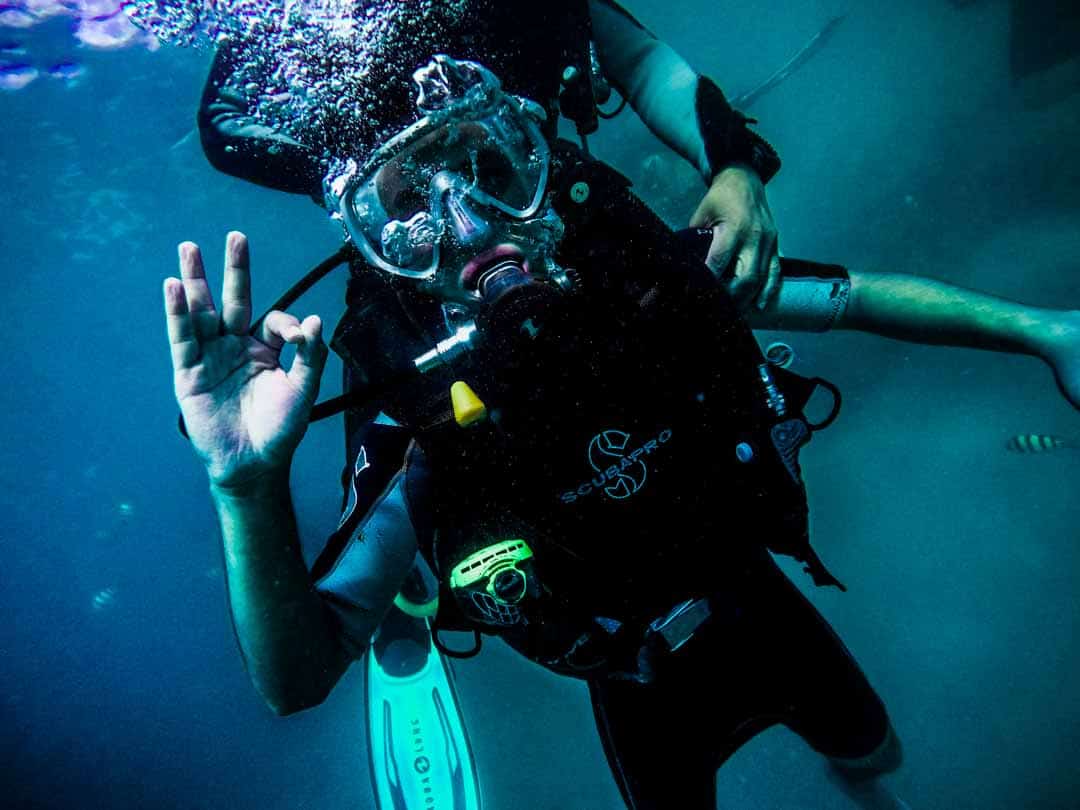It’s estimated that around 60% of a diver’s body heat escapes through their heads, which is why investing in a scuba hood, and diving gear in general, can make all the difference. Regardless of whether you’re diving in warm or cold water, a scuba hood can be beneficial, particularly when you consider that the rate at which water takes heat from the body is up to 20 times faster than air. By insulating your head and retaining body heat, you prevent fatigue (as your body won’t be working hard to replace lost heat) and be able to increase your bottom time.
BEST SCUBA HOODS IN 2023
- WATERPROOF High Visibility Polar Evo Hood
- MARES 6.5mm Trilastic Diving Hood
- ZCCO Diving Hood
- SEAC Men’s Ultraflex Tekno Hood
- SKYONE Scuba Hood
- WATERPROOF H1 3/5mm Vented Anatomical Hood
- NEO SPORT Multi-Density Wetsuit Hood
- BARE 7mm Ultrawarmth Dry Hood Scuba Diving Hood
- A POINT Wetsuits Premium Neoprene 1mm Sport Cap Hot Skins Hood
ALL THE SCUBA HOODS THAT WE TESTED
WATERPROOF High Visibility Polar Evo Hood
General Impression
Waterproof’s Polar Evo hood features a high-visibility part with appropriate reflective patches, to improve visibility, especially in murky and dark waters. It’s made from high-quality super-stretch i-span nylon and neoprene mixture which allows you to have maximum freedom of movement. The neck and face area have a glideskin seal to ensure that it doesn’t slide out while scuba diving. It also features two one-way valves and a HAVS (Hood Air Venting System) to ensure there’s no air buildup in your scuba dive hood.
Specifications
THICKNESS: 5/10 mm
MATERIALS: Neoprene
TEMPERATURE SUITED TO: Cold-water hood
PROS
- HAVS (Hood Air Venting System) with two one-way valves
- 5/10mm thickness for cold waters
- Super-stretch i-span nylon and neoprene mixture
CONS
- Pricey, but worth it
MARES 6.5mm Trilastic Diving Hood
General Impression
If you’re diving in chilly conditions, then this 6.5mm scuba hood from Mares is one of the best cold water scuba dive hoods on the market. It’s made from a Trilastic mix, with a low-compression neoprene at the top of the head to reduce pressure and 3mm neoprene around the face and bib. A super-elastic neoprene is used on the neck and sides of the hood to enable easy donning and removal. The interior of the scba hood is lined with Sapphire plush that’s designed to enhance heat retention, with sizes ranging from XS to XL available.
Specifications
THICKNESS: 6.5 mm
MATERIALS: Neoprene
TEMPERATURE SUITED TO: Cold-water hood
PROS
- Super-stretch panels for the ultimate in comfort
- Sapphire plush lining on the interior for comfort and enhanced heat retention
- 5mm hood with 3mm bib and skin-in face seal
- Low compression neoprene used at the top of the hood
CONS
- Limited stock all round
ZCCO Diving Hood
General Impression
The ZCCO scuba dive hood is made from premium Neoprene and super elastic Nylon fabric mixture that allows more freedom of movement. Unlike some of our other suggestions on the list, the ZCCO Diving hood has a short collar to ensure a better fit with most diving wetsuits. It comes in two different thicknesses 3 and 5mm and 5 different sizes from Small to XX-large. It’s important to note that this scuba dive hood does not have an air venting system so there might be some build up of air.
Specifications
THICKNESS: 3 mm
MATERIALS: Nylon, Neoprene
TEMPERATURE SUITED TO: Warm-water hood
PROS
- 90% Neoprene + 10% Nylon fabric
- Available in 3mm and 5 mm thicknesses
- Unisex
CONS
- Not very durable
SEAC Men’s Ultraflex Tekno Hood
General Impression
SEAC’s Tekno scuba hood is made from 5mm ultraflex neoprene that gives you unlimited freedom of movement. The anatomical shapes ensure it fits around your head comfortably. With the special “Air Release” vent system that releases air from the top of the hood, you won’t have any air buildup within your scuba hood. The neck has a bib that ensures a better grip between the hood and the wetsuit. The SEAC Tekno scuba hood is compatible with most wetsuits.
Specifications
THICKNESS: 5 mm
MATERIALS: Neoprene
TEMPERATURE SUITED TO: Cold-water hood
PROS
- 5mm Ultraflex Neoprene with Thermal Fiber lining
- “Air Release” vent system
CONS
- Tough to get over your head
SKYONE Scuba Hood
General Impression
The Skyone Scuba hood comes in two different thicknesses: 3mm and 5mm and it’s made of high-quality 150% stretch Neoprene for a comfortable fit while diving. The hood is glued and stitched for extra durability. It’s meant for protecting you from UV rays, for thermal protection, as well as for protection against sea lice. The Skyone Scuba Hood comes in 5 different sizes to ensure a comfortable fit around different heads.
Specifications
THICKNESS: 3/5 mm
MATERIALS: Neoprene
TEMPERATURE SUITED TO: Warm and cold-water hood
PROS
- Two different thicknesses 3mm and 5mm
- 150% stretch Neoprene for a comfortable fit
- Glued and stitched seams for extra durability
CONS
- Doesn’t seal that well around the face
WATERPROOF H1 3/5mm Vented Anatomical Hood
General Impression
Atop our scuba dive hood review is this anatomical dive hood, which combines 5mm protection in critical heat loss areas with a 3mm bib and glide-skin seals around the neck and face. It’s designed with a unique HAVS (Hood Air Venting System) that uses one-way valves to release air build-up inside the hood while all of the seals are glued and sewn with high-quality nylon thread for extra strength and durability. It’s an ideal scuba hood for diving in both warm and cold-water conditions, with sizes ranging from XS to XXL.
Specifications
THICKNESS: 3/5 mm
MATERIALS: Nylon II neoprene rubber
TEMPERATURE SUITED TO: Warm and cold-water hood
PROS
- 5mm double-layered protection in areas of critical heat loss
- Seals are glued and sewn for long-term durability
- Glide-skin seals ensure 100% waterproofing
- 3D-shaped anatomical sculpting for the ultimate in comfort
CONS
- Sizing is a bit small
NEO SPORT Multi-Density Wetsuit Hood
General Impression
Available in a variety of thicknesses, this Neo Sport scuba hood is made from an extra soft, form-fitting stretch neoprene. A custom-trim face seal combines with strongly stitched seams to prevent any water from seeping in while the high-quality neoprene allows air to pass through. This scuba hood is available in a range of sizes (from X-small to XX-large), together with 3/2mm, 5/3mm or 7/5mm models.
Specifications
THICKNESS: 3/5 mm
MATERIALS: Neoprene
TEMPERATURE SUITED TO: Tropical or cold water hood
PROS
- Large bib easily tucks into your wetsuit
- Face seal can be trimmed for a custom fit
- Available in a variety of thicknesses
- Design covers the chin while allowing you to use a regulator or snorkel
CONS
- Slightly small for normal sizes
BARE 7mm Ultrawarmth Dry Hood Scuba Diving Hood
General Impression
Keeping your body warm so you can dive for longer, this 7mm cold-water scuba dive hood harnesses Celliant infrared technology to conserve heat. It combines Elastek outer fabric with high loft Celliant inner fabric that reacts with your body’s heat, converting it to infrared energy and reflecting it back to your body. The scuba hood is double glued and blind-stitched for long-term use, with a trimmable face and neck for the ultimate fit. It comes complete with a mask strap grip pad on the back of the scuba hood to prevent your mask from slipping, making it one of the best scuba dive hoods available. Sizes range from S to XXL.
Specifications
THICKNESS: 7 mm
MATERIALS: Nylon and Celliant-lined neoprene rubber
TEMPERATURE SUITED TO: Cold-water hood
PROS
- Elastek outer fabric for stretch and high-loft Celliant inner fabric
- Double glued and blind-stitched seams for durability
- Neck seal meets with your wetsuit collar or dry suit seal
- Allows trapped air to escape without letting water enter
CONS
- Not durable enough
A POINT Wetsuits Premium Neoprene 1mm Sport Cap Hot Skins Hood
General Impression
A great warm water dive cap with a long neck, this simple wetsuit scuba hood provides a good level of protection for both scuba diving and snorkeling. The flat-lock seam system not only prevents water from entering these wetsuit scuba hoods but also reduces bunching, with an adjustable Velcro chin strap to ensure the fit you prefer. The A POINT Wetsuits Premium Neoprene 1mm Sport Cap comes in a range of sizes, from X to XL.
Specifications
THICKNESS: 1 mm
MATERIALS: Neoprene
TEMPERATURE SUITED TO: Warm water hood
PROS
- Constructed from a premium neoprene material
- Flat-lock seams for added comfort
- Adjustable Velcro chin strap for an easy fit
CONS
- Sizing inconsistent
BEST SCUBA HOODS
Buyer's Guide
Dive hood materials
The majority of scuba dive hoods are made out of neoprene, which is a flexible and spongy rubber material that’s filled with bubbles. These bubbles trap the heat that’s produced by a diver’s body, preventing it from being lost to the outside water and keeping the head (and body) warm throughout the dive. It’s for this reason that neoprene has become such a popular material for dive gear.
However, you can also find thin scuba dive hoods made from lycra, which are ideal for diving or snorkeling in warm water. They protect the head from UV rays or can be worn beneath a neoprene dive hood for extra warmth. Tech materials are also being produced for superb heat retention in 7mm cold water scuba dive hoods, featuring a combination of nylon outers and synthetic-lined inners.
Cold-Water vs Warm-Water Scuba Hoods
Generally speaking, the colder the water is, the thicker the neoprene in your dive hood should be. If you’re not sure what to purchase, the general rule of thumb is that 70°F (21°C) water requires 1-3mm thickness while 60-70°F (15.5-21°C) needs 4-5 mm and 50-60°F (10-15.5°C) needs 6-7 mm thickness.
However, the effectiveness of the scuba hood’s heat retention capabilities is also determined by its design. Most cold water scuba hoods have an insulated neck and a large bib that can be tucked inside your wetsuit to eliminate water flow. Many are also designed with a snug fit around the forehead and jaw while still allowing your mask to fit and a regulator to be used comfortably. This ensures as little of the diver’s face is exposed to the cold as is logistically possible.
Aside from being thinner, warm water scuba hoods usually cover less of the face and rarely come with a large bib. Some will also be made from lycra or nylon, which are not as good at insulating as neoprene but are less cumbersome and easier to don. Even if you’re not concerned about heat loss from your head while diving in warm waters, they can still offer useful protection against UV rays, stingers, and other sea irritants.
Finding the perfect fit
A dive hood should fit snuggly over your head and around the face to prevent water from flowing. But at the same time, it should not be too tight or uncomfortable in any way. Most modern dive hoods are made using an ultra-stretchy neoprene. This unique flexibility allows it to retract easily around your head when being donned which prevents water flowing in.
While most scuba dive hoods are just slipped over the head, you can also find those with zippers along the back of the hood to make them easier to fit, as well as hook and clip straps that sit beneath the chin and secure at the side of the face. These are worth considering if you have long hair that can make donning and removing traditional dive hoods cumbersome.
Will a scuba dive hood prevent hypothermia?
A fall in body temperature of just a few degrees can quickly lead to hypothermia, which can be a serious risk when diving in cold-water conditions. While most scuba divers would not think about getting in cold water without a wetsuit, overlooking the importance of a dive hood is more common. It’s at the extremities of the body that we lose a lot of heat, with the head one area that releases a high percentage. This is why protecting it with a scuba hood is so important, helping to prevent heat from escaping the body and reducing the risk of hypothermia.
Can I still equalize while wearing a scuba hood?
Some divers find it harder to equalize during descent while wearing a scuba hood. This is due to the snug fit of the scuba hood against the outer ear, which restricts the movement of water. This can be solved by inserting a finger under the hood near the ear to ease the flow of water or by cutting a hole inside the scuba hood near the ear canal through the inner lining. This will allow the water to move freely while still leaving the outer fabric intact.
Do I need a hood with a bib?
Whether you need a bib or not will depend on the type and design of wetsuit you are wearing. In most cases, a scuba hood with a bib that can be tucked into your wetsuit is a useful addition to prevent water seeping inside, as well as offering another layer of warmth. But in some cases, dry suits will have an insulated neck that is not suitable to bibs and a long-necked hood is a better choice.
How can I maintain my dive hood?
Just as you would rinse your wetsuit with fresh water after a dive, the same should be done with your hood to prolong its life. Salt will not only degrade the hood over time but can also cause irritation the next time you wear your hood. After rinsing, leave your hood out to dry away from direct sunlight, then store it somewhere that’s not subject to significant weight or pressure.
REACH OUT
As always, we create our content with you, fellow adventurers, in mind. So, how’d we do? Did you find this informative? Did it help you make a decision? Did we miss anything? We’d love to hear from you below. Thanks for reading and we hope your next adventure is a great one!






























